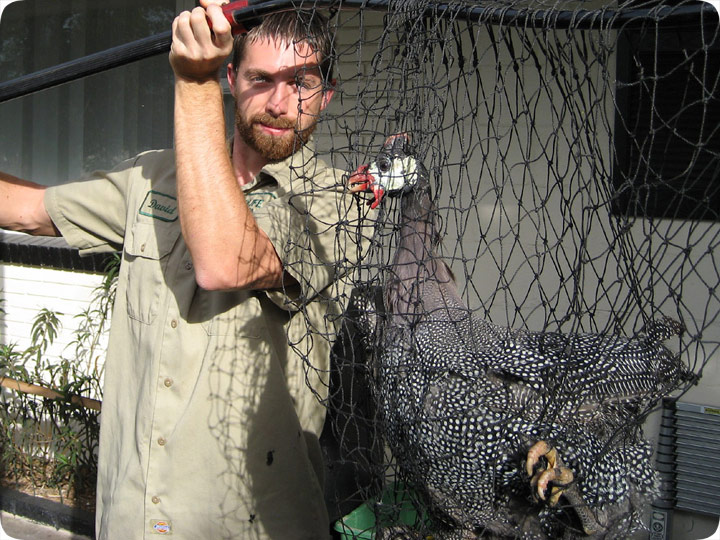-
info@aaanimalcontrol.com
Call us for help in your town
Humane Wildlife Education
Guinea Hen

11.30.2006 - Now here's a new catch! A Guinea Hen! I suspect that this fine bird was someone's pet, and then it either escaped or was abandoned. Either way, it wound up living on the steps at an apartment complex that I regularly service. This time, instead of
removing squirrels from the attic 3-stories high, I removed this feathery friend. Apparently the maintenance crew tried repeatedly to catch it and chase it away, but it stubbornly resisted capture and chasing, and had been living on a particular flight of stairs for
approximately a week, and thus I was called onto the scene. As I approached the bird, slowly stalking it with large net in hand and an evil gleam in my eye, I saw it raise its head alertly and prepare to take flight. I knew that it would escape and that I'd have to try
again another day, and I didn't want that. So instead, I walked away and hid the net, and put on a fine cap and simply strolled near the bird whistling a tune. My casual demeanor left the hen feeling calm, and I was able to approach it without raising alarm. I whistled
and strolled around the bird for some time, and when I'd gained its confidence, I lunged! I grabbed it by the wings and wrastled it to my hidden net place, amidst much squawking protest and flying feathers. I threw it in the net and put it in the truck and took it home.
The bird somehow gained respect for me, and became my new friend. I let it go on my lawn, and it stayed at my house for many weeks, pecking corn and sitting on my truck and pooping on my truck. At first I thought this was cute, but as the days wore on, I became less and less
enamored with this black and white clucker, and more annoyed. It was scratching up my lawn and chasing the mailman. Finally one morning I
Do it yourself: Visit my How To Get Rid of Birds page for tips and advice.
Get professional help: Visit my Nationwide Pro Directory of wildlife removal experts.
For more wildlife stories, click my Wildlife Blog
or click my below banner to hire a local trapper.
Although related to several domestic birds, the guinea hen is known for its unique physical appearance, a hairless head, and speckled feathers. One doesn't forget seeing these birds in a hurry. These birds originated from sub-Saharan Africa and are now found in a wide variety of locations, including India, America, and Europe. Guinea hens were seen in Europe as far back as the 5th century BC.
Types of guinea hen
The types of guinea hen include the domesticated and wild ones. The helmeted and vulturine guinea hens are some of the more domesticated species, with the helmeted guinea hen being the common domesticated type. Species found more in the wild and in large groups include the crested, white-breasted, plumed, and black guinea hen. The helmeted guinea hen is the commonly recognized one in the US.
Size and appearance
When fully grown, guinea hens can weigh up to 4 lbs., with a size that is similar to that of a large chicken. The combination of the short legs and short, rounded wings give the birds an oval shape. The skin on the head, which is hairless, has a combination of black, red, and blue hues. The beak of the guinea hen is short, stout, and curved.
One could differentiate the male and female guinea hens by their wattles, which are larger in males than in females. The female guinea hen may also not have wattles.
Behavioral patterns
Guinea hens are very social birds. They live and move in flocks. If a bird mistakenly leaves the flock, it calls out to other birds until they reunite. Although they can be domesticated and may co-exist with other birds, they sometimes prefer to roost on trees and other high places at dusk.
It is noteworthy that the birds hate the dark and can display aggressive behavior related to their pecking order.
Breeding
These unique birds attain sexual maturity at about 2 years old. The males and females can be distinguished by the sounds they make. The males make the “buck-wheat”, “buck-wheat”, “buck-wheat” sound, while the females make the “chi”, “chi”, “chi” sound.
Guinea hens lay eggs in seasons such as March/April and September/October and can lay up to a hundred eggs in a season. They are also communal breeders. Thus, multiple birds can lay eggs in nests that are built with durable camouflage materials. Communal breeding by guinea hens also includes communal nest sitting with the females taking turns to sit on the eggs. The eggs are usually small and hardy. The males also guard the females during this period. In the wild, the birds may have permanent mating partners for life.
When domesticated, guinea hens are free ranged or kept in a house. However, unlike other domestic birds, they require more space. Each bird requires about 900cm2 of space. Smaller spaces cause stress for the birds. Guinea hens, especially the helmeted type, are typically kept for ornamental purposes.




















